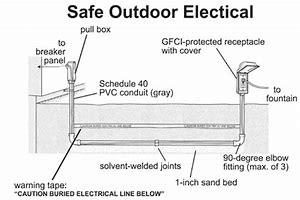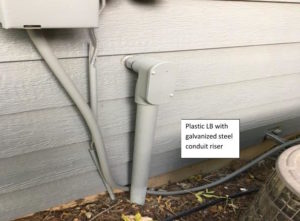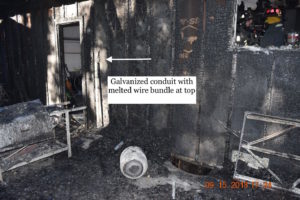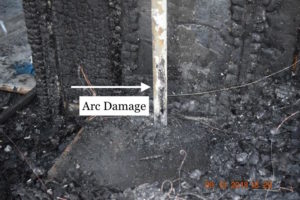
Firefighter Electrical Safety
“Hidden” Electrical Danger at Outside In Fires
-Captain Spencer Rice for Firefighter Craftsmanship
Download PDF Version HereOur fire department routinely experiences outside in fires. These often times create considerable damage to exterior mechanical systems of the structures. We recently had an outside in fire that damaged the electrical system feeding into the house and unfortunately due to the amount of the damage it was not recognized and we could have suffered severe consequences. Our city has the vast majority of our utilities buried under the ground and as such, when electrical drops come into the residence they often look like (fig.1)
What we have seen several times occur in our older homes is the pull box, also known as an LB, be constructed of lightweight aluminum or plastic. In a fire, these often melt or burn away and expose the wires. Another way these wires can be exposed is if the conduit is constructed of schedule 40 PVC…….again this plastic will not hold up to a well-developed fire and will eventually disintegrate; exposing the wires.
When these wires melt or are exposed they do not necessarily trip or go uncharged. Therefore you could have exposed hot wires on the side of the structure. In this instance, the residence had older conduit that was made of the galvanized steel pipe.
The wires in our case were still live and arced to the point that they burned through the galvanized steel pipe. Unfortunately this was not recognized until the investigation portion of the fire. City Utilities was called to the scene and they were able to pull the meter that was located at the rear of the property line. We do know people had come in contact with the pole and we were just very lucky nothing occurred.
Image of the arcing damage at the base of the riser
When dealing with outside-in-fires consider using an electrical current detection device like an AC Hotstick™ to identify energized wires or components. Like any testing device that works in a wireless fashion caution should be taken at all times when around exposed conductors of any kind. A safety officer, RIC team, or other resource could perform this inspection relatively quickly with a simple 360. Lastly, a good working relationship along with training with your local utility is paramount.
Captain Spencer Rice is currently assigned as the A-Shift safety officer with Poudre Fire Authority based in Ft. Collins CO. He started with PFA in 2005 and has served in many roles including in the training division and as an engine officer.
Download PDF Here










